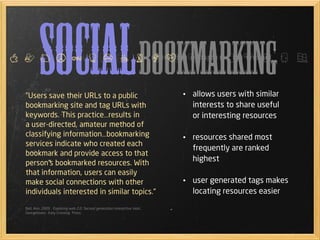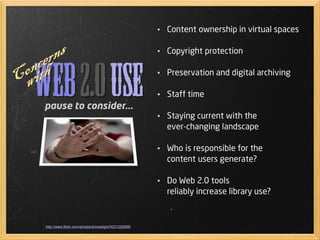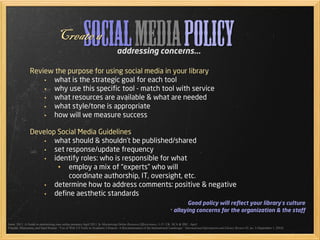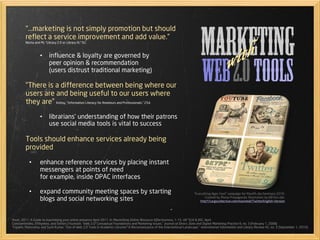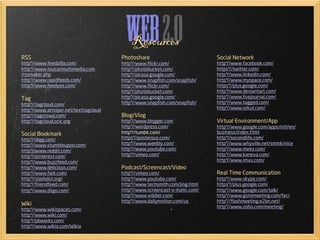Marketing2.0
- 1. Web2.0 Marketing with &Jennifer Wiley Jessica Gutacker V V
- 2. Web2.0“Web 2.0 is the network as platform, spanning all connected devices; Web 2.0 applications are those that make the most of the intrinsic advantages of that platform: delivering software as a continually updated service that gets better the more people use it, consuming and remixing data from multiple sources, including individual users, while providing their own data and services in a form that allows remixing by others, creating network effects through and "architecture of participation”, and going beyond the page metaphor of Web 1.0 to deliver rich user experiences.” http://radar.oreilly.com/archives/2005/10/web_20_compact_definition.html “a perceived second generation of web-based communities and sharing between users” Bell, Ann. 2009. Exploring web 2.0:Second generation interactive tools. Georgetown:Katy Crossing Press.
- 3. Topics http://www.fotopedia.com/items/flickr-4859806074 Overview of Web 2.0 Key Features Web 2.0 Tools: • RSS feeds • tagging & folksonomy • social bookmarking • photosharing • blogging/vlogging • podcasting/vodcasting/screencasting • wikis, social networking • virtual environments and application • multi-user environments • real-time communication Concerns Social Media Policy Marketing with Web 2.0 Tools Marketing and Crowd-sourcing Examples Ideas for Library Use of Web 2.0 Best Practices Resources Sources
- 4. http://www.arteyfotografia.com.ar/8867/fotos/363687/ • many use multi-purpose, open source formats allowing for easy modification/remixing • dynamic, interactive applications & interfaces • Encourages user participation & creation • content is heavily user- generated multi-media • continuous & seamless updating Web2.0key features
- 5. “Online syndication is a technology standard that allows any online publisher to broadcast information on the Internet in feeds. Users can link to the information in these feeds.“ Shuen, Amy. 2008. Web 2.0:A atrategy guide. Sebastopol: O'Reilly Media, Inc. http://www.argazkiak.org/photo/rss/ • Content available at the users convenience • Used for checking news sites, blogs, medical sites, product pages, etc • Provides only desired content, eliminating the “extras” • Simplified frequent content updates attracts users • Attract more users to sites/ blogs by creating an RSS feed RSSfeedsa.k.a. content aggregators
- 6. “Allow users to affix descriptive labels or keywords to content. When people tag content collaboratively it creates a folksonomy, essentially a bottom-up, organic taxonomy that organizes content on the web.” Tapscott, Don, and Anthony D. Williams. 2006. Wikinomics:How mass collaboration changes everything. New York: Penguin. Jessica Gutacker TagsFolksonomy& • organic & social categorization • increases “findability” of content • updates immediately • encourages exploration • less expensive to maintain than a traditional taxonomy • spelling & variants (plurals) are a common problem
- 7. W R o Y S J X V e L B x F c Q r C SocialBookmarking ”Users save their URLs to a public bookmarking site and tag URLs with keywords. This practice…results in a user-directed, amateur method of classifying information…bookmarking services indicate who created each bookmark and provide access to that person's bookmarked resources. With that information, users can easily make social connections with other individuals interested in similar topics.“ Bell, Ann. 2009. Exploring web 2.0:Second generation interactive tools. Georgetown: Katy Crossing Press. • allows users with similar interests to share useful or interesting resources • resources shared most frequently are ranked highest • user generated tags makes locating resources easier W R o Y S J X V e t B
- 8. PhotosharingSocial Photography sites allow users to, “post, share, and comment on the photos they take.” The platforms for hosting the photos is provided by the company. Users do everything else. “Users add all the content…they create their own self-organizing classification system for the site. They even build most of the applications members use to access, upload, manipulate, and share their content.“ Tapscott, Don, and Anthony D. Williams. 2006. Wikinomics:How mass collaboration changes everything. New York:Penguin. Jennie Wiley • photos can be: • classified into albums • keyword tagged • grouped into galleries • comment streams can be created by users & viewers • notes and geo-tagged data can be added to photos O
- 9. Blogging http://klearchosguidetothegalaxy.blogspot.com/2007_01_01_archive.html • common blog types: personal, news, activist, political, education, technology, corporate/industry, celebrity, hobby • constantly updated &archived • comments, trackbacks & links all contribute to an extended readership • each new post gets a permalink, keeping it accessible after archiving • often used in professional development & best practices • requires frequent updates to show life/activity; infrequent updates discourage use “web sites, often either personal or focused on specific topics, that have regular postings and maintain a history of old postings.” Shuen, Amy. 2008. Web 2.0:A atrategy guide. Sebastopol:O'Reilly Media, Inc. Vlogs are video blogs Blogs & Vlogs both have RSS syndication feeds &vlogging
- 10. Podcastsscreencastsvideos• podcasts can deliver audio content to any MP3 or computer capable of syncing to Windows media player, iTunes, or Real Player • screencasts & videos can be embedded in websites or uploaded to sites like Youtube & Vimeo • both target audio & video broadcasts to unique markets • be aware:vodcasts require high-speed internet “Podcasting is a process of automatically receiving time-shifted audio or video from a personally selected subscription via a podcast- enabled RSS 2.0 feed to a portable media device through the Internet.” Publishing finished videos to the internet requires a Saas (ie. YouTube) which converts, “uploaded video into Flash format and provides a URL link or HTML coding that can be embedded in a Web site or blog” Bell, Ann. 2009. Exploring web 2.0:Second generation interactive tools. Georgetown: Katy Crossing Press
- 11. Wikis “allows multiple users to create and edit the same Web page. It is built on the premise that collaboration among users will improve content over time” Tapscott, Don, and Anthony D. Williams. 2006. Wikinomics:How mass collaboration changes everything. New York:Penguin. http://www.cyberlawcentre.org/unlocking-ip/blog/2007_08_01_archive.html • captures community knowledge through collaboration, combining Web site & document • relies on peer production over hierarchy • wiki community values: openness, peering, sharing & global action • discussion board forums:used to ask questions and engage in conversation about content and edits occurring in the wiki V
- 12. ”Social networks create a new and unique opportunity to share not only written ideas, but visual and musical creations as well, with everyone unbound by the physical limits created by the location where one lives.” Bell, Ann. 2009. Exploring web 2.0:Second generation interactive tools. Georgetown:Katy Crossing Press. http://mediaspin.com/blog/?paged=2 • pages/groups can be developed for: products, interests, & common causes • pages can be recommended by its friends to their friends • friends can post content and comments are the default • social networks are social spaces unlimited by time and distance • social networks and other sites are beginning to include Geo-positional options for broadcasting to your networks your real-time location. SocialNetworking
- 13. • virtual environments are often multi- player games or spaces like Second Life • opportunity to create spaces, meet people, and collaborate on activities not possible in real life • virtual applications include Google apps & Windows Live where multiple users can collaborate http://www.flickr.com/photos/nmcvirtualworlds/3792112907/ Virtual environments are “3-D, Web-based communities that allow interaction among users and devices” using avatars. Tasner, Michael. 2010. Marketing in the moment:The practical guide to using web 3.0 marketing to reach your customers first. Upper Saddle River, New Jersey:Pearson Education, Inc. Virtual applications can boost productivity & efficiency through sharing, editing, & collaborating on documents, calendars, etc. Virtualenvironments applications &
- 14. Uses VoIP (voice over Internet protocol) for easy and inexpensive transmission of real-time voice communication. Real-time communication includes chat and instant message functions. • options include: Skype,Twitter, GoogleTalk, & GoToMeeting • real time communication includes: voice, video, & chat functions • multiple callers/users can often communicate simultaneously • real time communication is included in some virtual applications & social networking tools Realtimecommunication W
- 15. • Content ownership in virtual spaces • Copyright protection • Preservation and digital archiving • Staff time • Staying current with the ever-changing landscape • Who is responsible for the content users generate? • Do Web 2.0 tools reliably increase library use? http://www.flickr.com/photos/shinealight/3021229588/ Web2.0usepause to consider...
- 16. SocialMediaPolicy Review the purpose for using social media in your library • what is the strategic goal for each tool • why use this specific tool - match tool with service • what resources are available & what are needed • what style/tone is appropriate • how will we measure success Develop Social Media Guidelines • what should & shouldn’t be published/shared • set response/update frequency • identify roles: who is responsible for what • employ a mix of “experts” who will coordinate authorship, IT, oversight, etc. • determine how to address comments: positive & negative • define aesthetic standards Anon. 2011. A Guide to maximising your online presence April 2011. In Maximising Online Resource Effectiveness, 1-15. UK: SCA & JISC, April. Tripathi, Manorama, and Sunil Kumar. “Use of Web 2.0 Tools in Academic Libraries: A Reconnaissance of the International Landscape.” International Information and Library Review 42, no. 3 (September 1, 2010) addressing concerns... Create a Good policy will reflect your library’s culture allaying concerns for the organization & the staff
- 17. “Everything Ages Fast” campaign for MaxiMídia Seminars 2010. Created by Moma Propaganda. Illustration by 6B Estúdio. http://cargocollective.com/maximidi/TwitterEnglish-Version “...marketing is not simply promotion but should reflect a service improvement and add value.” Nesta and Mi, “Library 2.0 or Library III,” 92. • influence & loyalty are governed by peer opinion & recommendation (users distrust traditional marketing) “There is a difference between being where our users are and being useful to our users where they are” Koltay, “Information Literacy for Amateurs and Professionals,” 254. • librarians’ understanding of how their patrons use social media tools is vital to success Tools should enhance services already being provided • enhance reference services by placing instant messengers at points of need for example, inside OPAC interfaces • expand community meeting spaces by starting blogs and social networking sites Anon. 2011. A Guide to maximising your online presence April 2011. In Maximising Online Resource Effectiveness, 1-15. UK:SCA & JISC, April. Constantinides, Efthymios, and Stefan J Fountain. “Web 2.0:Conceptual Foundations and Marketing Issues.” Journal of Direct, Data and Digital Marketing Practice 9, no. 3 (February 1, 2008) Tripathi, Manorama, and Sunil Kumar. “Use of Web 2.0 Tools in Academic Libraries:A Reconnaissance of the International Landscape.” International Information and Library Review 42, no. 3 (September 1, 2010) Web2.0tools Marketing
- 18. Starbucks is an excellent example of effective crowdsourcing MarketingCrowdsourcing& Starbucks Coffee Company & Barnes & Noble facebook pages Pull in outsider ideas to co-create with social media: instant focus group • why? democratic decision making, balances interests, potential to boost user engagement/participation, develop a greater variety of creative ideas • cultivate participants • concise content • capture interest first, then fill in details • be consistent, to alleviate user confusion • offer incentives for participation Decisions are never final. Use social media to grow with your audience, know your audience & better target your message Chakravorti, Bhaskar. 2010. “Stakeholder Marketing 2.0.” Journal of Public Policy & Marketing 29 (1): 97-102. doi:10.1509/jppm.29.1.97. Constantinides, Efthymios, and Stefan J Fountain. “Web 2.0: Conceptual Foundations and Marketing Issues.” Journal of Direct, Data and Digital Marketing Practice 9, no. 3 (February 1, 2008)
- 19. Library Facebook Pages: The Huntington Library and Gardens: excellent showcasing Columbus Metropolitan Library: great graphics and images Multnomah County Library: tons of fans New York Public Library: great fan page Library Blogs: Academic Librarian Library Garden The Merry Librarian The “M” word - Marketing Libraries Flickr Streams: Library of Congress photo stream Boston Public Library Photostream The library stream (ilovelibraries.com) Library videos/channels: Toronto Public Library http://www.youtube.com/user/torontopublic library?ob=0&feature=results_main New York Public Library http://www.youtube.com/user/NewYorkPu blicLibrary?ob=0&feature=results_main Folger Library http://www.youtube.com/user/FolgerLi brary?ob=0&feature=results_main The Unquiet Library http://www.youtube.com/user/theunqui etlibrary?ob=0&feature=results_main exemplary Web2.0 libraries use of in
- 20. • open a video channel with tutorials on how to download library e-books or, search the catalog/databases. Post videos of special events, story-time and craft demonstrations, including virtual tours of the library • form a “virtual coffee house,” to generate new ideas & listen to user interests • start a photostream of visiting authors, renovations, volunteers and staff, community/school events, virtual tours of the library and don't forget to tag & share them! • create a blog with an RSS feed to promote new items, discuss books, authors, library issues, tips for researching, upcoming programs • build a social networking page advertising upcoming events, lectures, guest speakers, tutorials, book groups, take surveys/polls, co-create/ participate in new library planning, even provide point of need reference services. Start conversations and engage opinions • use a social bookmarking site to share url’s for research, reference, and reader’s advisory purposes • form a Wiki where staff, faculty, & students create the content • cultivate participants by identifying incentives and applying them as motivation incentive samples (for authoring a new library tag-line): publicly credit the author of the winning idea, grant them library “friend‘”status, or forgive library fines for a year Library Web2.0 tools Ideas for use of
- 21. BestPractices• find marketing opportunities by freely experimenting with current and new technologies • assemble & circulate a social web policy/guide to library workers • create an authentic message • follow & measure Web 2.0 tool usage • establish & maintain Web 2.0 tools whereby individual staff assume responsibility for & coordinate between a variety of roles for different areas of expertise • update frequently • reach & inform online opinion leaders (bloggers, podcasters, etc) about your services/products • make tools findable to search engines by describing content accurately & thoroughly. (titles, descriptions, keywords, tags, etc.) • know your audience • be humble, be open, be honest • ‘listen-in’ to customer voice • actively seek one-on-one engagement/interaction/feedback • build community:offer users ability to connect with & exchange information with peers • shape web architecture (2.0) around point of user need, “help users become successful” • provide convenient, personalized, value rich services & products • create flyers on library’s Web 2.0 tools to distribute to new patrons or at orientation • offer courses on using Web 2.0 tools (boost usage by teaching/showing what’s available) • Facilitate user generated content Anon. 2011. A Guide to maximising your online presence April 2011. In Maximising Online Resource Effectiveness, 1-15. UK:SCA & JISC, April. Constantinides, Efthymios, and Stefan J Fountain. “Web 2.0:Conceptual Foundations and Marketing Issues.” Journal of Direct, Data and Digital Marketing Practice 9, no. 3 (February 1, 2008) Kaplan, Andreas M., and Michael Haenlein. 2010. Users of the world, unite!The challenges and opportunities of social media. Business Horizons 53 (1) Parise, S., and P. J. Guinan. 2008. Marketing using web 2.0. Paper presented at Hawaii International Conference on System Sciences, Proceedings of the 41st Annual Waikoloa, HI. Tripathi, Manorama, and Sunil Kumar. “Use of Web 2.0 Tools in Academic Libraries:A Reconnaissance of the International Landscape.” International Information and Library Review 42, no. 3 (September 1, 2010)
- 22. RSS http://www.feedzilla.com/ http://www.toucanmultimedia.com /rssmaker.php http://www.rapidfeeds.com/ http://www.feedyes.com/ Tag http://tagcloud.com/ http://www.artviper.net/texttagcloud http://tagcrowd.com/ http://tagcloud.oclc.org Social Bookmark http://digg.com/ http://www.stumbleupon.com/ http://www.reddit.com/ http://pinterest.com/ http://www.buzzfeed.com/ http://www.delicious.com/ http://www.fark.com/ http://slashdot.org/ http://friendfeed.com/ http://www.diigo.com/ Wiki http://www.wikispaces.com/ http://www.wiki.com/ http://pbworks.com/ http://www.wikia.com/Wikia Photoshare http://www.flickr.com/ http://photobucket.com/ http://picasa.google.com/ http://www.snapfish.com/snapfish/ http://www.flickr.com/ http://photobucket.com/ http://picasa.google.com/ http://www.snapfish.com/snapfish/ Blog/Vlog http://www.blogger.com http://wordpress.com/ http://tumblr.com/ https://posterous.com/ http://www.weebly.com/ http://www.youtube.com/ http://vimeo.com/ Podcast/Screencast/Video http://vimeo.com/ http://www.youtube.com/ http://www.techsmith.com/jing.html http://www.screencast-o-matic.com/ http://www.viddler.com/ http://www.dailymotion.com/us Social Network http://www.facebook.com/ https://twitter.com/ http://www.linkedin.com/ http://www.myspace.com/ https://plus.google.com/ http://www.deviantart.com/ http://www.livejournal.com/ http://www.tagged.com/ http://www.orkut.com/ Virtual Environment/App http://www.google.com/apps/intl/en/ business/index.html http://secondlife.com/ http://www.whyville.net/smmk/nice http://www.meez.com/ http://www.kaneva.com/ http://www.imvu.com/ Real Time Communication http://www.skype.com/ https://plus.google.com/ http://www.google.com/talk/ http://www.gotomeeting.com/fec/ http://flashmeeting.e2bn.net/ http://www.zoho.com/meeting/ Web2.0Resources
- 23. • Anon. 2011. A Guide to maximising your online presence April 2011. In Maximising Online Resource Effectiveness, 1-15. UK: SCA & JISC, April. • Chakravorti, Bhaskar. 2010. “Stakeholder Marketing 2.0.” Journal of Public Policy & Marketing 29 (1): 97-102. doi:10.1509/jppm.29.1.97. • Constantinides, Efthymios, and Stefan J Fountain. “Web 2.0:Conceptual Foundations and Marketing Issues.” Journal of Direct, Data and Digital Marketing Practice 9, no. 3 (February 1, 2008):231–244. • Bell, Ann. 2009. Exploring web 2.0:Second generation interactive tools. Georgetown:Katy Crossing Press. • Bughin, Jacques, Michael Chul, and Andy Miller. 2009. How companies are benfitting from web 2.0:Mckinsey global survey results. McKinsey on Business Technology(17) (Autumn):10-7. • Kaplan, Andreas M., and Michael Haenlein. 2010. Users of the world, unite!the challenges and opportunities of social media. Business Horizons 53 (1) (0):59-68. • Koltay, Tibor. 2011. “Information literacy for amateurs and professionals:The potential of academic, special and public libraries.” Library Review 60 (3) (January 1): 246-257. doi:10.1108/00242531111117290. • Nesta, Frederick, and Jia Mi. 2011. “Library 2.0 or Library III:returning to leadership.” Library Management 32 (1/2) (January 1): 85-97. doi:10.1108/01435121111102601. • O'Reilley, Tim, and John Battelle. 2009. Web squared:Web 2.0 five years on. Paper presented at Web 2.0 Summit, . • Parise, S., and P. J. Guinan. 2008. Marketing using web 2.0. Paper presented at Hawaii International Conference on System Sciences, Proceedings of the 41st Annual Waikoloa, HI. • Qualman, Erik. 2009. Socialnomics:How social medis transforms the way we live and do business. Hoboken, New Jersey:John Wiley and Sons, Inc. • Shuen, Amy. 2008. Web 2.0:A atrategy guide. Sebastopol:O'Reilly Media, Inc. • Sodt, Jill M., and Terri Pedersen Summey. 2009. Beyond the library's walls: Using library 2.0 tools to reach out to all users. Journal of Library Administration 49 (1-2) (02/26; 2012/02): 97-109, http://dx.doi.org/10.1080/01930820802312854. • Tapscott, Don, and Anthony D. Williams. 2006. Wikinomics:How mass collaboration changes everything. New York:Penguin. • Tasner, Michael. 2010. Marketing in the moment:The practical guide to using web 3.0 marketing to reach your customers first. Upper Saddle River, New Jersey:Pearson Education, Inc. • Tripathi, Manorama, and Sunil Kumar. “Use of Web 2.0 Tools in Academic Libraries:A Reconnaissance of the International Landscape.” International Information and Library Review 42, no. 3 (September 1, 2010):195. Sources






